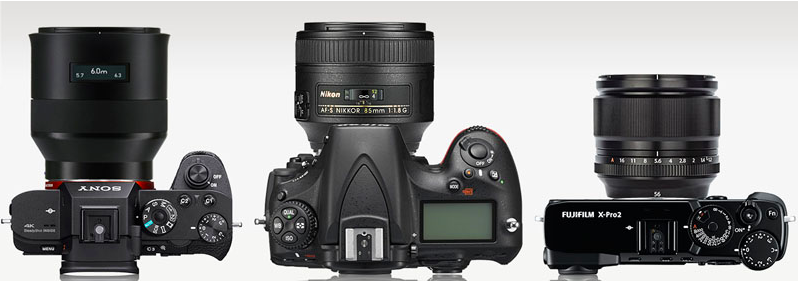“Sony’s Full Frame Mirrorless is a Fatal Mistake.” APS-C (and Fuji) is better! + The Answer of SonyAlphaRumors!

A7rII + Zeiss 85mmF1.8 Batis Vs. Nikon D810 + the 85mmF1.8 Vs. Fuji X-Pro2 +XF56mmF1.2
_ _ _
There is an article at Petapixel, that is creating quite a buzz. Many FR-reader dropped me a link to it. In short: Sony’s Full Frame Mirrorless is a Mistake (and some are afraid that Fujifilm will Make The Same Mistake one day. Here some reasons:
- Compactness: Full Frame lenses are Big, so you lose the size advantage of mirrorless cameras. “In many cases, Sony FF mirrorless works out as being bigger than a comparable DSLR.” […] If compactness really were your priority, you would choose the Fuji 56mm f/1.2, which also allows you to shoot faster in low light.”
- Weight: “The next answer you will hear is that a FF mirrorless body is still lighter and the height or width might be a bit less. However, that’s partly because Sony put such a miniscule battery in their FF mirrorless bodies that you end up having to carry multiple batteries, which negate any size advantage.”
- In Body Image Stabilization: In this case they quote a Sigma CEO, who said: “…the diameter is very small and makes it difficult to design high quality FF lenses … it almost looks like E-mount was designed for APS-C more than FF“.
You might remember how a Fuji Manager said here, that IBIS is not good for X-mount because “The diameter of our mount was designed for the image circle without IBIS. It means the amount of light at the corners is reduced when the sensor is shifted. We could correct it digitally, but we don’t want to do it: we don’t want to compromise our image quality.” So the conclusions they make at the petapixel article is that “if you want IBIS, you have to design the mount in advance with a wider diameter, so that it doesn’t compromise corner IQ as the sensor moves around. What you don’t do is take an APS-C mount (NEX mount), turn it into a FF mount, then forcibly retrofit IBIS onto a mount never designed to take it in the first place.” - Sony FF Mirrorless not good for ultra-wide angle: “Zeiss has admitted that the short flange distance of the FE mount makes it technically challenging to design ultra wide-angle lenses, because the short flange distance between the sensor and the rear element is an engineering challenge for ultra wide-angle lenses. At really short focal lengths, the light hits the corners at too steep an angle, which is exacerbated by IBIS when the sensor moves. It isn’t without reason that Sony have yet to come up with any high quality wide-angle zoom lenses for the FE mount.”
All in all it looks like APS-C (and Fujifilm) is the better way to go for the reviewer.
Before you start the discussion, you should read the response of SonyAlphaRumors. He highlights a few “errors”:
- Size: It’s not the “mirrorless” aspect that makes Sony FF attractive. But mirrorless is necessary for most of these innovative features to exist.
- Big lenses: The lenses are big because it’s high quality glass, for example the [shoplink 44295 ebay]new 85mm GM lens[/shoplink] is made for ultimate quality. […] Sartor, the author of the article, did not take into account that lenses are also designed for different image quality performances.
“Let’s make a more fair comparison: Here is the Zeiss FE 35mmF2.8 Vs the XF18mmF2.0 (29mm f/3.0 FF equivalent) comparison by CameraSize (re-aligned on the LCD screen)”
So SAR’s conclusion is that: “Owning a Sony A7 camera gives you an extreme flexibility: If small size is what matters you can use small APS-C or FF lenses on the very same E-mount. If extreme quality is what matters you can use the bigger FF GM lenses. Such a flexibility is yet second to none in the camera business
- IBIS: SonyAlphaRumors says that Sartor doesn’t bring a real actual proof to support his thesis.
Check out the Full articles at SonyAlphaRumors and Petapixel… and then feel free to drop your own considerations in the comments.

